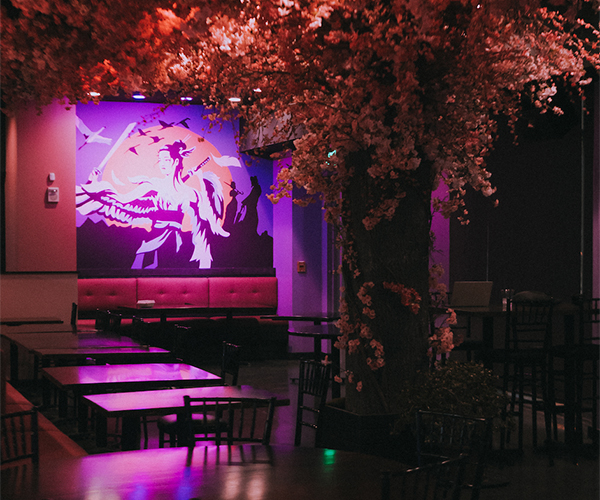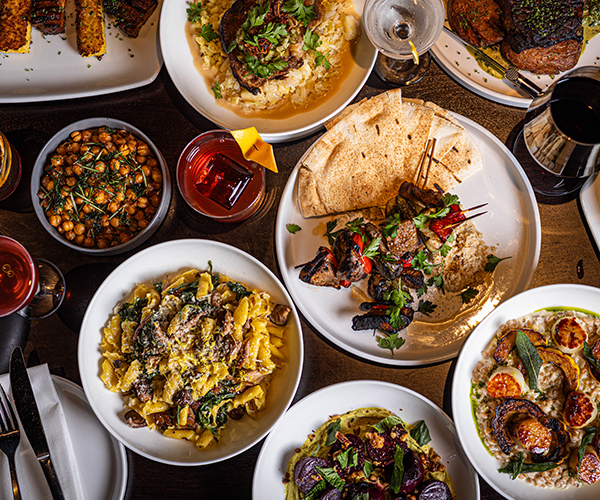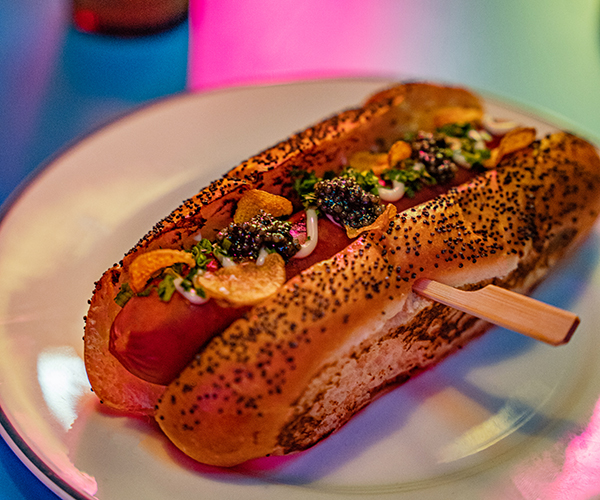Cork and Cleaver social kitchen
Say the best new restaurant in Northeast Ohio is in an unassuming shopping center in Broadview Heights, and you'll get a look of confusion. But trust us, there's nothing ordinary about Brian Okin and Adam Bostwick's Cork and Cleaver Social Kitchen. With a menu full of inventive dishes such as pork paprikash and a gluttonous array of roasted bone marrow, seared foie gras and braised pork belly known as the Board, these brothers-in-law are proof that chef-driven restaurants serving upscale, mouthwatering food do exist outside neighborhoods such as Tremont or Ohio City. The duo dishes with us about family, bacon and their hard-to-define cooking style.
CM: Why open a restaurant in the suburbs, especially back at the spot where you started?
BO: We were here for four years [as Italian spot Benvenuti], so the neighborhood already knew us. It shortened the learning curve — we were coming back to a place that we already had a good reputation. Nothing against Ohio City, Tremont or East Fourth, but they're so oversaturated. Every single night, without question, somebody says, "Thanks for bringing Tremont closer to us."
CM: It seems that local chefs feel the need to have more than one restaurant. Do you feel pressure to expand?
AB: My mind turns a mile a minute. Sometimes the format of what we do here doesn't fit the vision of what I want to do. It would give us more of a creative outlet. Obviously, it's just a part of being successful. I think we'd be idiots not to want more.
BO: If you're a creative person, you want to keep expanding on that. We want to be very careful on that. One of the unique dynamics of what we do is that we have two chefs under one roof. Two or three restaurants might be it. If you start getting to five, six, seven, eight restaurants, you start watering yourself down. Adam and I can't be at eight different places at once.
CM: You two are family, so how's that?
AB: It's fine. To be honest, we rarely don't see eye to eye, which is really weird. And if we don't, my sister will be the final say-so for most of it.
CM: You think it's fine?
BO: Yeah, or we wouldn't be sitting here. We don't necessarily do things the same way they do at a corporate restaurant because we're family. Everybody that works here has worked for me or Adam before. There's a lot of trust going on. We spend a lot of time together, and you don't want it to feel like a job.
AB: I look forward to going to work. We joke too much, we have too much fun. It's almost like a fun house behind the scenes that no one would ever know.
CM: How did you two meet then?
AB: He and my sister, Amanda, worked together at another restaurant, and they started dating. I have a big, tight-knit family. All my cousins are my best friends. Brian kind of came into it shell-shocked at first, because everybody knows everybody's business in my family. So Brian got introduced to us pretty quick.
CM: How would you describe your cooking style?
BO: It's almost like we're this yin-and-yang thing. Obviously, I'm a few years older than Adam.
AB: A few?
BO: OK, 14. My style is more traditional, straightforward. I'm a huge fan of Thomas Keller and how he looks and thinks about food. Adam is more whimsical and likes to reinvent the wheel. When you put those two together, it can get pretty interesting. There's no definition of what we're doing — it's whatever we want to do, we can use whatever flavors we want.
AB: I like to have fun with food. I'm a pretty simple eater for the most part. I'll go home and eat peanut butter and jelly most nights. But then my mind starts working on that: How do I make peanut butter and jelly crazy? I like to take what you're used to and flip it on its head.
CM: Is there any ingredient that you wish diners would embrace more?
AB: Three of my favorite ingredients are eggplant, fennel and sweetbreads. We've had them all on the menu, so it hasn't been an issue. It's going to sound weird, but I'm going to put a hillbilly charcuterie board on the menu with fried pepperoni and bologna pate — not your typical fancy cured meats. We'll see how that goes. We don't want to be a restaurant where someone is afraid to bring a 4-year-old.
CM: What do Brian's kids like to eat when they're here?
AB: They order the Board every time they come here, and they call the bone marrow "bow and arrow" because they don't really know what they're saying.
BO: They are 5 and 6 so they don't know any better to not like it. I have a picture of my son sitting next to my mother-in-law eating the Board, and she's so disgusted by it. She's looking away. She can't even watch him eat this bone marrow, and he's just killing it.
CM: Speaking of kids, did you want to be a chef when you were younger?
AB: At my grandmother's house, I would have pots and pans and throw [in] Legos and crayons, pretending I was cooking stuff all the time. I was always talking about how I wanted to open an Italian restaurant when I was younger. My grandfather owned five barbershops, so the two things I wanted to do growing up was cut hair and cook — so I went with one.
BO: My mom was a lousy cook, so I didn't have that same experience. I got the bug for the business because my mom was dating one of the cooks at Nighttown. I was 15, I think, and I begged them to get me a job. I just thought, Oh, my God, these guys are rock stars with their big floppy hats and their chefs coats — they are badass. I started as a busboy, and they finally pulled me in the kitchen. I knew from that point that's what I wanted to do.
CM: Do you have an ingredient you don't like to use?
AB: Don't get me wrong, I like bacon and I think it can add flavor to things. We obviously use it. But if I was told that I could never cook with bacon again, I would be completely OK. I know that sounds crazy, because everyone has this huge obsession with it and puts it in everything. But, come on — think outside the box.
BO: The thing with bacon is that it does bring a lot of flavor to the table. A lot of meats don't have that natural intensity of flavor that pork does, and I think that's why it's used as much as it is. I don't dislike it like he does.
AB: I wouldn't say, "dislike," but you'll never see me go out to breakfast and order bacon. I'm a sausage person.
CM: Why can't you have sausage and bacon?
AB: I'd rather just have extra sausage.
Jennifer Plank
My dad had a roofing company, and I remember going with him when I was 5 years old to pick up his crew of Amish men. We lived in Burton, and they lived one town away from us in Middlefield. I loved watching how they lived off the land. It also sparked something in my dad. We started growing tomatoes, squash, watermelon and all our own herbs a couple years later. My dad groomed me to be responsible for what we started together.
I knew from the age of 11 watching the Food Network's Two Fat Ladies with my dad that I wanted to be a chef. I was 14 years old when [chef] Matt Harlan allowed me to plate some cookies at Lola, and Michael Symon gave me a copy of [Michael Ruhlman's] The Reach of a Chef and a T-shirt.
The first time I killed a chicken, it shook me up pretty hard. It was four years ago, when Jonathon Sawyer sent his chefs to his chicken farmer. He wanted us to see firsthand where our food came from. One minute the chicken was alive, the next minute I had taken its life. That's why it's so important to us to utilize every part of the animal when coming up with menu dishes. Pig ears and lamb's tongue barely sell, but we're trying to educate people to be open-minded and learn to love byproducts as our grandparents did.
Joe has an urban garden down the street [from Toast] with 12 chickens that supply our eggs. We'll have bees this summer to make our own honey. It's always been second nature to me to harness what our land offers. — as told to Kathy Ames Carr
Bac Nguyen
My earliest memories of cooking with my mom would be at home making things I make at my restaurant like spring rolls. It takes a lot of time, rolling those things, to really know how to do them perfectly.
I grew up in the restaurant business back before it was a rock star thing to be a restaurateur or chef. It was never a glorified thing in my home. It was just an honest living. Growing up, I didn't really want to own a restaurant or be a chef, but then through owning the restaurant I developed my own style that blended what my mom and grandmother did and had Western influences.
It's kind of ironic. Growing up, I never wanted to eat Asian food. I wanted to eat pizza, burgers, fried chicken. I really developed a stronger appreciation of both my food and my culture as I got older. To me, the food we do is an interpretation of the best of both worlds. This is authentic Asian food interpreted by an Asian guy who's grown up in America.
Mom still helps out. Mom's a part of this place. I own the place, but she's still the boss. She comes by and treats this like her kitchen at home. I've got good cooks now in the kitchen. She's just another member of the team. At the end of the day, to have somebody who has done this and has the experience and technique is invaluable. — as told to Kelly Petryszyn
Douglas Katz
I don't know if it was all the windows or the fact that I'd spent all this time there as a teenager, but I just got a gut feeling that this was where I wanted to be.
In the beginning, the restaurant didn't have a name. But after working on the space, I knew that the kitchen was going to be the main focus of the dining room. In restaurant kitchens, the chef says "fire" about 1,000 times a night. It's a culinary term that means "start cooking." Fire also connotes a warm atmosphere, and I wanted the restaurant to have an approachable feel.
When I opened at Shaker Square, I began using the local farmers who would come to the North Union Farmers Market each week. I always planned my menus based on seasonal products, but as I found more and more local foods, it added to the ability to make the menu items even more special.
It's funny, some of the things I thought would never sell — such as bison meatballs, chicken livers — are now some of our most popular appetizers. And other things I thought would be big hits — lobster, strip steak — have ended up being big duds.
It took 11 years to open my next restaurant, but I thought about it for eight years. Provenance at the Cleveland Museum of Art opened in 2012. [The Katz Club Diner] opened only one year afterward.
I probably won't do another restaurant. But the next time something comes up that's really exciting, I tend to forget all my resolve. It's like a candy bar. You see it and it looks really tempting. You forget, though, how awful you feel after you eat it. — as told to Rebecca Meiser



